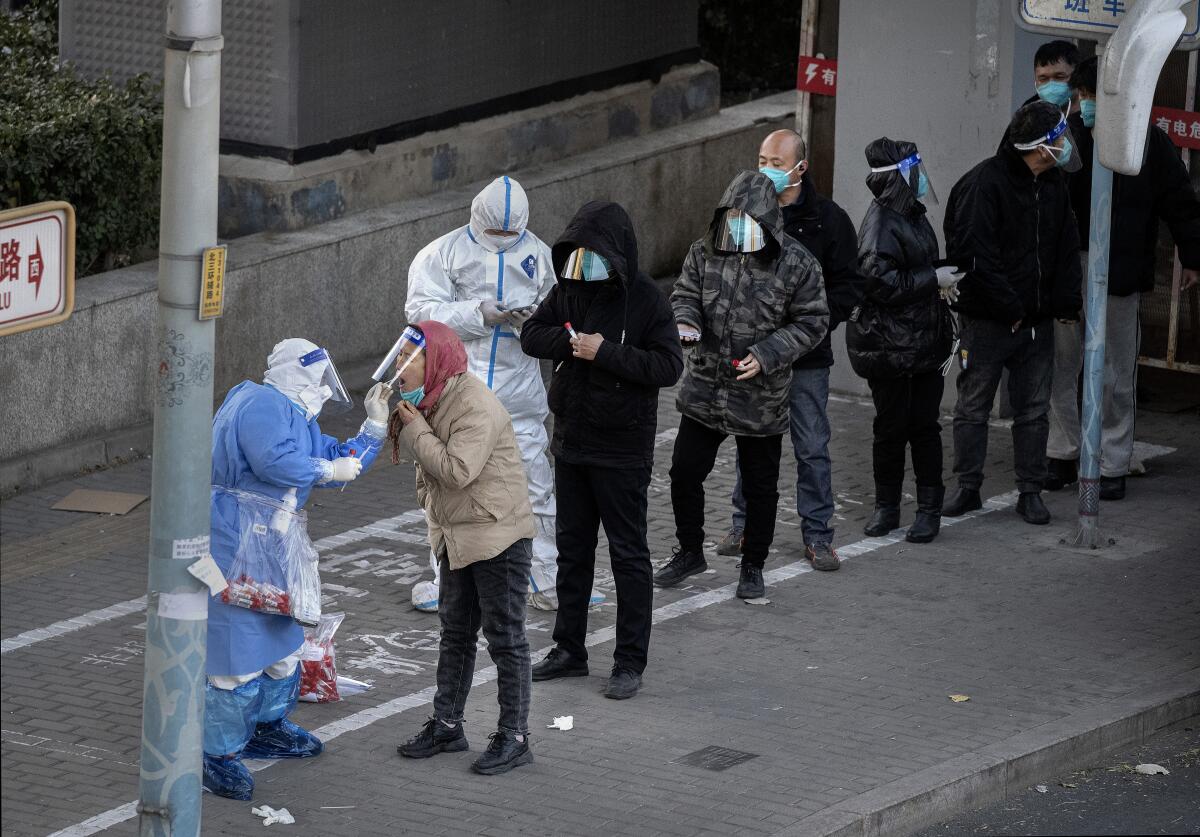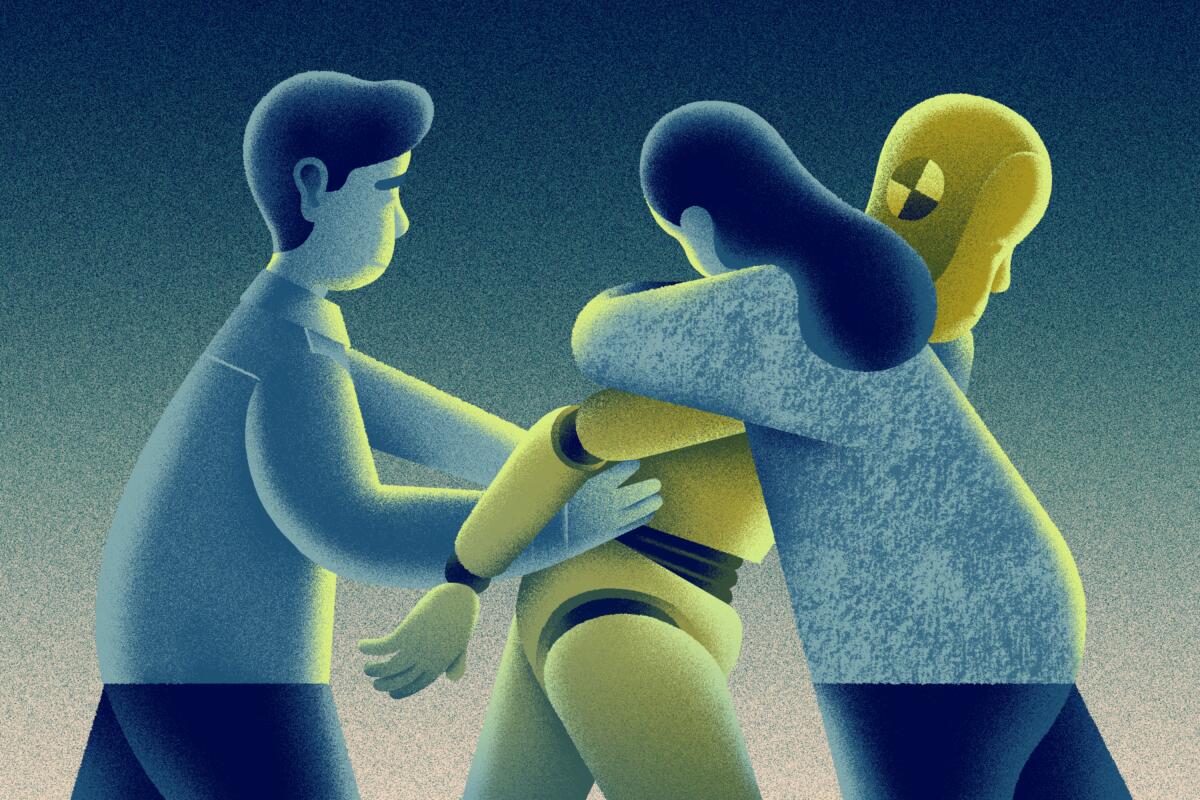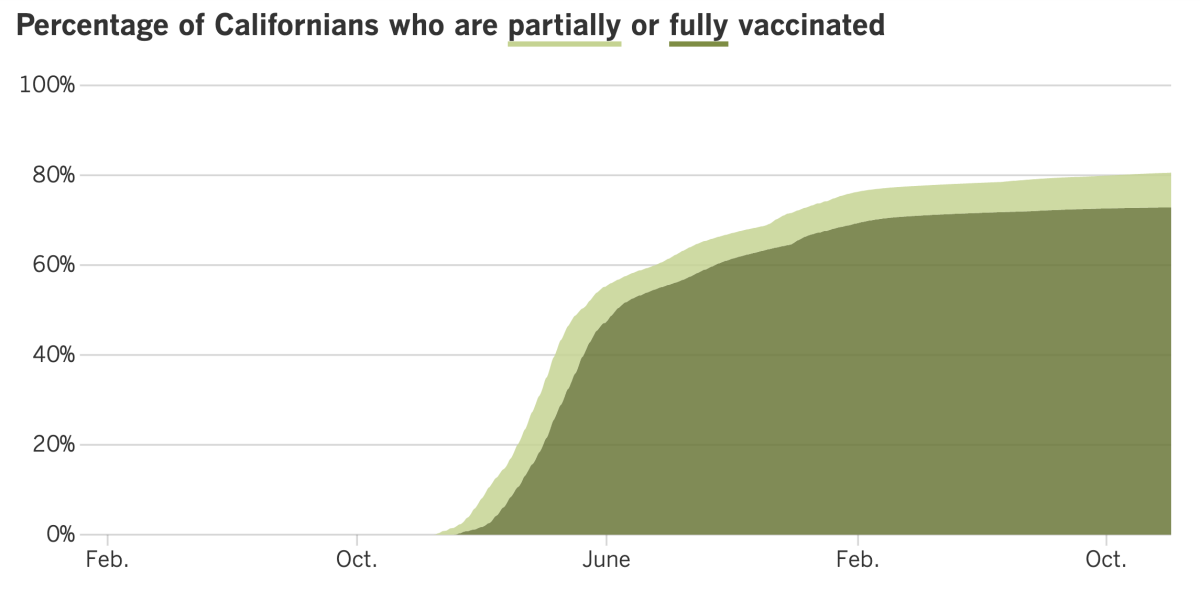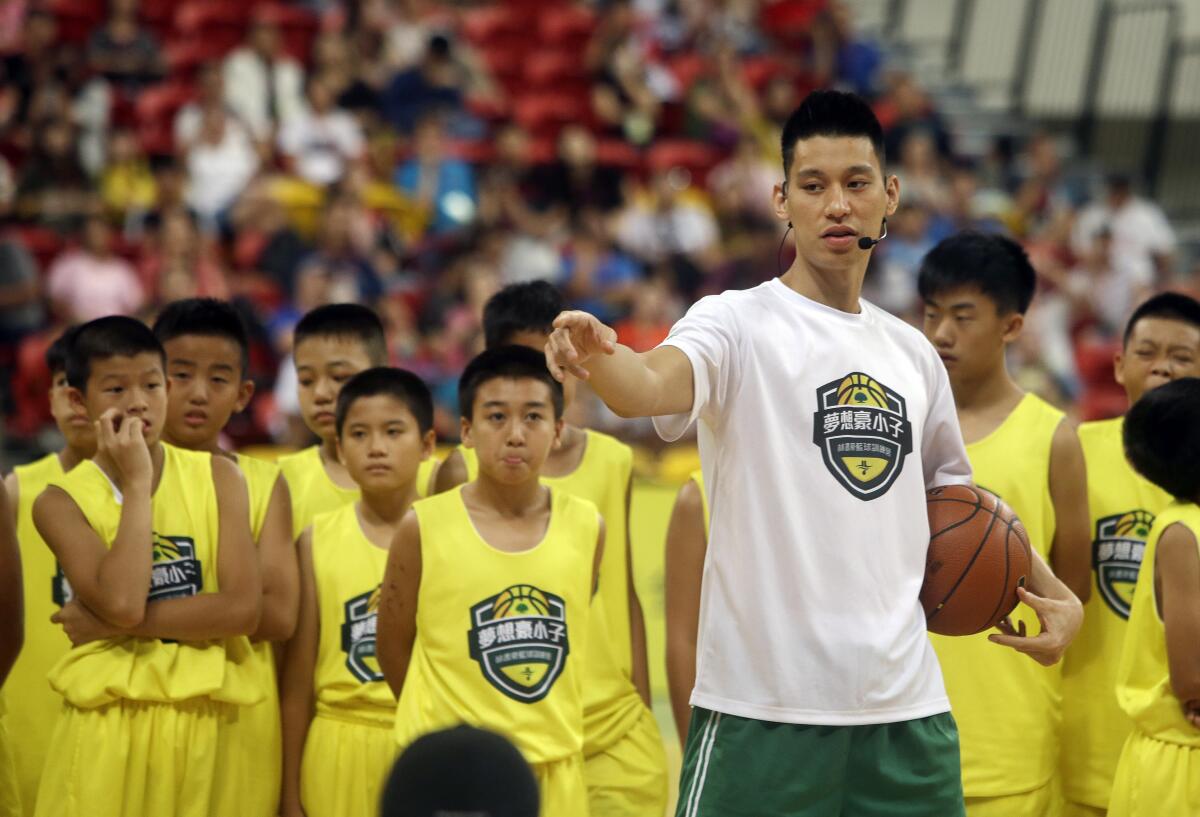Coronavirus Today: Has China set itself up for a COVID disaster?
Good evening. Iâm Karen Kaplan, and itâs Tuesday, Dec. 6. Hereâs the latest on whatâs happening with the coronavirus in California and beyond.
Nearly every week of late, this newsletter has included at least one story about residents of China becoming increasingly frustrated with the countryâs âzero COVIDâ policy.
There was the news from Sichuan province about anxious people being forced to stay in their homes after a magnitude 6.8 quake shook buildings, triggered landslides and killed 93 people.
âLift the lockdown, refuse to be tested,â protesters in Wuhan chanted afterward.
There was the bus crash in Guizhou province that killed 27 people who were being transported to a quarantine center in the middle of the night.
âWill this ever end? ... Is there scientific validity to hauling people to quarantine, one car after another?â wondered one of many who registered their discontent on social media.
There was the 3-year-old boy in Gansu province who died of carbon monoxide poisoning from a suspected gas leak after his fatherâs attempts to call an ambulance were blocked by workers enforcing a quarantine of the familyâs residential compound. Quarantines are meant âto protect life and health, not to confront those who need to be rescued with obstacles!â one person wrote on the popular Sina Weibo social media service.
And as Americans celebrated Thanksgiving, 10 people in Urumqi in the northwest Xinjiang region lost their lives in an apartment fire whose death toll may have been exacerbated by lockdown rules that prevented residents from fleeing and slowed firefightersâ response. That calamity triggered protests in Beijing, Shanghai, Nanjing and Hong Kong, among other cities. Some even called for Chinese President Xi Jinping and the ruling Communist Party to step down.
âNo PCR tests but freedom!â students in Hong Kong chanted. âOppose dictatorship, donât be slaves!â
Some Chinese cities, including major ones, have eased coronavirus rules in recent days. Guangzhou, Shijiazhuang, Chengdu and others relaxed testing requirements and allowed residents to move around more. Beijing and at least 16 other cities stopped making access to public transportation contingent upon a negative test result. Shenzhen, the technology manufacturing powerhouse, opened its pharmacies, parks and tourist attractions. There was even a report that some infected people in Beijing would be allowed to isolate at home instead of having to report to crowded quarantine centers.
But if too many rules are abandoned too quickly, even the most passionate of protesters might come to regret it. The reason: Zero COVID has turned the country of 1.4 billion into a coronavirus tinderbox, my colleagues Stephanie Yang and Melissa Healy report.
The point of zero COVID is to squelch potential outbreaks as soon as possible to minimize illnesses and deaths. In the pandemicâs early days, that meant shutting down entire cities, blocking major highways and canceling international flights.
Even today, officials still require citizens to be tested on a daily or near-daily basis. The use of mobile health codes restricts residentsâ movements, and tracking programs make it possible to quickly identify the close contacts of an infected person.
Just a handful of infections can prompt a protracted lockdown, which has been happening more often lately thanks to the Omicron variantâs amazing propensity to spread. A Beijing-based research firm called Gavekal Dragonomics reported that 95 of Chinaâs top 100 cities by economic output had implemented COVID-19 restrictions as of Nov. 22.

For a long time, the strategy achieved its stated aims. The self-reported death toll for mainland China is below 5,300, and although some independent experts suspect that the true number is higher, they agree that the countryâs death rate is among the lowest in the world. Xi considers it one of his crowning achievements and insists that zero COVID will remain in place for as long as itâs needed.
But thereâs a downside to this success. Iâm not talking about the shortages of food and medical supplies that afflict people in locked-down areas, or the recent tragedies that seem to have galvanized protesters. Iâm talking about the fact that the Chinese population has little natural immunity to what is now a highly contagious virus.
Efforts to impart immunity through vaccination have provided some protection. The countryâs National Administration of Disease Prevention and Control said 90% of residents were fully vaccinated with homegrown COVID-19 shots as of mid-November. But coverage is considerably lower for the oldest citizens, who are most vulnerable to becoming severely ill or dying if they are infected. Among those 80 and older, only 66% are fully vaccinated, and only 40% have had a booster.
To get an idea of what China may be in for if its zero-COVID rules are relaxed too much too soon, consider what happened to Hong Kong when Omicron overpowered its pandemic precautions in February.
The city was overwhelmed in a matter of weeks. The daily death toll climbed from zero to nearly 300, forcing morgues to store bodies in refrigerated containers because they ran out of coffins. There were so many patients in need of care that medical centers rolled additional beds outside, and a convention center was converted into a temporary COVID-19 hospital. The bulk of the cityâs roughly 10,800 COVID-19 deaths occurred during the surge between mid-February and early May. Close to 90% of the victims were 70 and older, an age group with a vaccination rate below 45%.
Or consider what happened in Shanghai this spring when authorities attempted to loosen restrictions there.
Once given a little leeway, Omicron swept through hospitals and elder-care facilities, resulting in a two-month lockdown that ensnared around 26 million people. Residents forced to stay in their homes ran dangerously low on food and medicine. Some got a change of scenery only because they were sent to quarantine facilities. Those moves sometimes resulted in parents being separated from their children. Virtually all of the cityâs nearly 600 deaths occurred during the surge.
These examples make one thing clear: China will have to get a lot more senior citizens vaccinated before it can safely relax its zero COVID rules. And indeed, authorities have emphasized that this is a priority.
Experts also say China needs more effective vaccines and treatments, as well as more medical resources. The country is estimated to have four ICU beds per 100,000 people; the U.S., by comparison, has 27.
Beyond that, itâs unclear what a zero-COVID exit plan would look like. But Chinaâs leaders will have to figure it out.
âWithout a coordinated and coherent plan, it might just lead to a rapid increase in cases, and then you will find the healthcare system quickly overwhelmed,â said Yanzhong Huang, senior fellow for global health at the Council on Foreign Relations and an expert on public health in China. âThat will defeat the very purpose of the Chinese pandemic response.â
By the numbers
California cases and deaths as of 4:51 p.m. on Tuesday:

Track Californiaâs coronavirus spread and vaccination efforts â including the latest numbers and how they break down â with our graphics.
How to handle hugging
December is the month for holiday parties, and you may encounter family members, friends and acquaintances you havenât seen for a long time. When you lay eyes on them, the urge to go in for a hug may overtake you. Should you let it?
For many of us, hugging was de rigueur before the pandemic made touching taboo. The coronavirus is still out there â and as contagious as ever â but thanks in part to immunity from vaccines and past infections, hugging is making a comeback.
For some, itâs a sign of progress thatâs long overdue. For others, itâs a fresh cause for anxiety.
âItâs like the Wild West,â New York University social psychologist Tessa West told Jen Doll. âDuring the pandemic, we went into a really awkward period where we started to just elbow each other instead of hugging. ... Now, especially, we just donât have implicit norms around these types of behaviors.â

If youâre unsure how to handle hugging, hereâs a guide to help you out.
Donât assume you can tell who wants a hug. West says itâs not possible to predict whoâs a hugger based on their body language or even their past hugging behavior.
However, if someone is wearing a mask, thatâs a pretty clear sign they wouldnât be receptive to having you in their personal space, said Tamika Lewis, founder of WOC Therapy Inc. That means hugging is off the table.
Donât force anyone to hug against their will. If someone reaches out to initiate a handshake, donât make the unilateral decision to escalate to a hug. Just shake their hand, and donât take it personally.
âThe golden rule is treat people as you want to be treated,â said etiquette expert Lisa Mirza Grotts. âJust respect their space.â
Ask if youâre unsure. It might feel awkward, but itâs better to be safe than sorry. All you have to say is, âAre you a hugger?â
âWhen in doubt, I would err on the side of at least getting permission,â said Mia Schachter, a consent educator. âIf you are not checking in, youâre likely hugging a bunch of people who donât want to hug you.â
Consider being proactive if you donât want to be hugged. You can preempt a full-body embrace by reaching out for a fist bump or a handshake.
Or, if youâre first to arrive and already seated, simply remain in your chair. Itâs really hard to hug someone who isnât standing up.
Prepare for the possibility of a hug. Deciding in advance what to say if someone approaches with outstretched arms will make it easier to respond if and when it happens. Something casual like âIâm not a big huggerâ will work, Lewis said.
You could also employ a white lie and tell would-be huggers that youâre getting over an illness, so it would be safer to keep their distance.
Californiaâs vaccination progress

See the latest on Californiaâs vaccination progress with our tracker.
Your support helps us deliver the news that matters most.
In other news ...
Remember when public health officials warned us to be careful when we met up with friends and family over Thanksgiving? Remember how they said the coronavirus would spread if we didnât take sensible precautions? It turns out they knew what they were talking about.
In Los Angeles County, cases have risen 75% week over week â and the full impact of Thanksgiving gatherings probably hasnât hit us yet. But the increase we have seen was enough to get L.A. County Public Health Director Barbara Ferrer to break out the âsâ word.
âThere is mounting evidence that we are entering another COVID-19 surge,â she said.
The countyâs case rate now stands at 258 per 100,000 residents per week, a figure not seen since the summer wave began to fade in early August. The rate probably would be even higher if it accounted for the results of at-home tests that arenât reported to health officials. To give you a little perspective, any rate that breaks the 100 barrier is considered high.
With the super-contagious Omicron variants, things can change quickly. The current case rate is double that of just before Thanksgiving and three times higher than it was just a month ago.
Itâs not just cases that are rising. The number of hospitalized patients with coronavirus infections is climbing as well. As of Tuesday, the county had 11.9 new admissions per 100,000 residents per week, according to the Centers for Disease Control and Prevention.
An admission rate in the double digits is one of the criteria county health officials are using to determine whether to reinstate a mask mandate for indoor public spaces. The other is the percentage of hospital beds taken up by infected patients. That figure now stands at 5.6%; if it reaches 10%, the countdown to a new mask order will begin. Ferrer has said that could happen in late December if present trends continue.
The previous countdown, back in July, was set to last two weeks. Luckily, hospitalization rates improved during that two-week period, and the threatened mask order was averted.
âI know nobody is anxious to hear this message from us that we need to protect each other again, but [if we want to] take actions at this point to help our healthcare system, we have to do it now,â Ferrer said. âWe have to really make sure that weâre able to do everything we can to reduce the number of people that are going to need a hospital bedâ â not just for COVID-19 but for its âtripledemicâ fellow travelers, flu and RSV.
Los Angeles has the highest coronavirus case rate among Californiaâs 25 most populous counties, but itâs not the only one moving in the wrong direction. The CDCâs map of COVID-19 community levels now places L.A., Orange, Santa Clara, Fresno and Sacramento counties in the âmediumâ tier, among many others. A week ago, nearly the entire state was in the âlowâ category.
Health officials are concerned about the growing number of senior citizens being admitted to hospitals with coronavirus infections. As of Sunday, the statewide hospitalization rate among residents 70 and older stood at 8.84 per 100,000, according to the CDC. That exceeds the peak of 8.36 per 100,000 during the summer surge.
For Californians in their 60s, the hospitalization rate stood at 2.51 per 100,000 residents as of Sunday, just about double the rate recorded Nov. 11. The summertime peak for this age group was 3.03 per 100,000.
COVID-19 vaccines â especially a recent booster shot â could help keep seniors out of hospitals. But at last check, only 35.8% of Californians 65 and older had received the new Omicron-targeting booster shot, which has been available free of charge since September. Public health leaders are working to improve that figure.
You know whoâs really bullish on COVID-19 vaccines? U.S. Defense Secretary Lloyd J. Austin III. Over the weekend, he gave a full-throated endorsement of the shots and said the militaryâs vaccine mandate would be staying put.
âWe lost a million people to this virus,â Austin said. âA million people died in the United States of America. We lost hundreds in DOD. So this mandate has kept people healthy.â
More than 20 U.S. governors have taken a different view. The governors, all Republicans, asked President Biden to remove the vaccine mandate on the grounds that it was hindering efforts to recruit troops into the National Guard. Austin was not moved by that argument.
âIâm the guyâ who ordered the military to require the vaccine, he said. âI support continuation of vaccinating the troops.â
And finally, Pfizer and BioNTech have asked the Food and Drug Administration to adjust the COVID-19 vaccine regimen for the youngest children so it includes one shot that targets Omicron.
Currently, children 6 months to 4 years get a primary series that includes three shots of the original formulation, each of which is one-10th the amount administered to adults. The companies would like to switch the third shot â which is given at least eight weeks after the second one â so it contains the bivalent booster instead of the original vaccine.
COVID-19 vaccines for the littlest kids were authorized in June, and theyâre not exactly popular. The CDC says only 2% of those under 2 and 4% of those ages 2 to 4 have received them. Kids under 5 are not yet eligible for COVID-19 booster shots.
Your questions answered
Todayâs question comes from readers who want to know: Is there a test that can confirm my belief that Iâve never had a coronavirus infection?
Not in all cases. But if youâre wrong and you actually have been infected, thatâs easier to prove.
The primary way doctors would check for evidence of a past infection is to take a blood sample and look for coronavirus antibodies.
Finding antibodies to the virusâ spike protein would signal that a person has been exposed to the virus or to a COVID-19 vaccine (or both). If the person is unvaccinated, you could safely conclude that he or she had been infected. But if the person is vaccinated, this result wonât do much to clear things up.
A more useful test would be to search for antibodies to the virusâ nucleocapsid protein, which isnât used in COVID-19 vaccines. Someone with these antibodies could have them only as a result of exposure to the virus itself.
But these antibodies donât hang around forever. So if you donât have them, it doesnât mean youâve never had a coronavirus infection; it only means you havenât had one in the last several months.
Itâs possible that someone infected in the pandemicâs early days could still have enough antibodies to be detectable with a blood test, said Dr. Aaron E. Glatt, chief of infectious diseases at Mount Sinai South Nassau in Oceanside, N.Y. But he wonders why anyone would bother to check.
âThe value of that is a little bit in question,â he said. âIs it for bragging rights? The tests you would need are available, but I wouldnât recommend it.â
We want to hear from you. Email us your coronavirus questions, and weâll do our best to answer them. Wondering if your questionâs already been answered? Check out our archive here.
The pandemic in pictures

Chinese citizens arenât the only ones critical of the countryâs zero-COVID strategy. Apparently, former NBA star Jeremy Lin wasnât happy with the quarantine hotel he checked into last week with his current team, the Guangzhou Loong Lions of the Chinese Basketball Assn.
âCan you believe this is a weight room?â Lin was quoted as saying in a video he was said to have posted. âWhat kind of garbage is this?â
The video was taken down after Lin learned that he would be staying in the hotel only briefly to comply with zero-COVID rules, according to a Shanghai news outlet called the Paper. But it was up long enough to earn him a fine of 10,000 yuan (about $1,400).
Linâs âinappropriate remarks about quarantine hotel-related facilities ... caused adverse effects on the league and the competition area,â the CBA said in a statement.
Lin, who is coaching young basketball players in Taiwan in the photo above, was the NBAâs first American player of Chinese or Taiwanese descent.
Resources
Need a vaccine? Hereâs where to go: City of Los Angeles | Los Angeles County | Kern County | Orange County | Riverside County | San Bernardino County | San Diego County | San Luis Obispo County | Santa Barbara County | Ventura County
Practice social distancing using these tips, and wear a mask or two.
Watch for symptoms such as fever, cough, shortness of breath, chills, shaking with chills, muscle pain, headache, sore throat and loss of taste or smell. Hereâs what to look for and when.
Need to get a test? Testing in California is free, and you can find a site online or call (833) 422-4255.
Americans are hurting in various ways. We have advice for helping kids cope, as well as resources for people experiencing domestic abuse.
Weâve answered hundreds of readersâ questions. Explore them in our archive here.
For our most up-to-date coverage, visit our homepage and our Health section, get our breaking news alerts, and follow us on Twitter and Instagram.




